Accessories and Documentation
In the hardware box you will find one larger bag that contains all that can be seen above. There are four wire ties next to the extra stand-off. You also get bags of hard drive screws, 2.5″ drive screws, long fan screws, motherboard and PSU screws, and fat aggressive thread fan screws.
In another bag that you will find inside of the liner, but outside of the chassis is what I have in this image. There is a large fold-out of paper that is the Quick Start Guide for the chassis, and a little pamphlet for the two year warranty information.
As you unfold the paper and look inside, you will see the exploded diagram from the back of the packaging. If you can familiarize yourself with the 12 components that are addressed in the image and with descriptions, you are 95 percent ready to go.
The other five percent of the build is finding and using the correct hardware for the job at hand. The back of the guide will give you a count and description of each type of screw with an image of both the profile view, as well as looking directly at the head of the screws to help you distinguish between similar ones supplied.
Packaging
Corsair sticks with the plain brown box with black screening to help save money. They do, however, use the space well to deliver not only an image of the windowed chassis, but also take the time to list the feature on the right in both English and French.
This side of the packaging offers the specifications chart in three languages above dimensional renderings of the chassis at the bottom in the black stripe.
Around the back, Corsair again uses all of the room to provide more information. At the top is a fully exploded diagram of the chassis covering every movable or removable part. The bottom information, in the black stripe, is the same as the features on the front, now listed in four other languages.
While somewhat blocked by the shipping tags, this side is much like the opposite side. This time the three charts are done in another three languages, covering the same as the features lists do.
Internally, to protect the chassis, Corsair sends the 350D with plastic stuck to the outside of the window, and the front panel gets taped in place. Once that is done, the chassis is enveloped in a plastic liner with thick Styrofoam caps on the top and bottom to keep the chassis safe in transit. It all worked very well as the Obsidian 350D arrived here in perfect shape.
Страница 1: Тест и обзор: Corsair Obsidian 350D — корпус Micro-ATX для high-end системы
Корпус micro-ATX обычно не сочетается с системами водяного охлаждения. Но в случае Corsair Obsidian Series 350D мы получили мини-башню micro-ATX, которая позволяет легко установить внутрь систему водяного охлаждения. Поскольку корпус относится к топовому семейству Corsair, мы получаем весьма приличное оснащение. В нашу тестовую лабораторию как раз поступил компактный корпус Obsidian Series 350D, в статье мы попытаемся оценить, насколько хорошо он подходит для high-end конфигурации в формате micro-ATX.
Если вы хотите приобрести новый корпус, то на рынке можно встретить большое разнообразие моделей от разных производителей. Но из всей серой массы обычно могут выделиться лишь несколько корпусов, поэтому производители постоянно ищут способы придать своим продуктам уникальные черты. Corsair, например, учел, что немногие корпуса в штатной комплектации подходят для установки мощной системы водяного охлаждения. Поэтому две последние модели в семействе Obsidian Series нацелены на тех пользователей, кто планирует охлаждать конфигурацию с помощью СВО.
Несмотря на одинаковый фокус и дизайн, две упомянутые модели существенно отличаются друг от друга. В случае Obsidian Series 900D (тест и обзор) мы получаем крупный корпус HPTX, созданный для масштабных проектов. Корпус Obsidian Series 350D более скромный. Corsair ориентировала самый компактный (и дешёвый) корпус семейства Obsidian Series на установку, максимум, материнских плат Micro-ATX. Подобный шаг кажется нам вполне логичным. На рынке уже есть материнские платы для энтузиастов в компактном формате (например, линейка Gene от ASUS), с другой стороны производители предлагают не так много корпусов в формате micro-ATX, которые подошли бы для систем водяного охлаждения. И у Obsidian Series 350D действительно есть уникальное преимущество: в корпус Micro-ATX вы сможете установить целых два 240-мм теплообменника. Кроме того, корпус позволяет инсталлировать даже high-end комплектующие. Внутри уместятся две high-end видеокарты и кулер-башня.
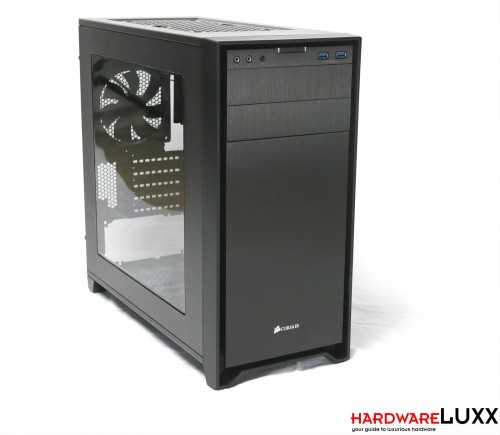
» Fotostrecke
Мы рекомендуем посмотреть наш видеоролик распаковки и первого знакомства Corsair Obsidian Series 350D:
Также вы можете посмотреть видеоролик на YouTube.
Комплект поставки не самый богатый. Вы получите аксессуары монтажа (нам не хватило винтов крепления блока питания), руководство пользователя и несколько кабельных затяжек.
Перед тем, как мы перейдём тестам, позвольте привести ключевые спецификации в табличном виде:
| Основные характеристики: Corsair Obsidian Series 350D | |
| Производитель и модель: | Corsair Obsidian Series 350D |
| Материал: | Сталь, пластик, алюминий |
| Габариты: | 210 x 440 x 450 мм |
| Форм-фактор: | Micro-ATX, Mini-ITX |
| Отсеки накопителей: | 2x 5,25″ (внешние), 2x 3,5″ (внутренние, опционально могут использоваться для 2,5″ приводов), 3x 2,5″ (внутренние) |
| Вентиляторы: | 1x 120 мм (сзади, предустановлен), 2x 140/120 мм (спереди, 1x 140 мм предустановлен), 2x 140/120 мм (сверху, опционально) |
| Вес: | Около 6 кг |
| Цена: | 102 евро в ЕвропеУзнать цену в России |
<>Тест и обзор: Corsair Obsidian 350D — корпус Micro-ATX для high-end системыCorsair Obsidian 350D | Внешний вид (1)
Inside the Obsidian 350D
The first look inside of the 350D looks very roomy. The wiring from the front I/O has been tied up behind the tray and is just poking out into the very large CPU back plate access hole. The hardware can be found in the HDD bay on the floor of the chassis in the brown cardboard box.
At the top you are given two 5.25″ bays that use tool-free clips on this side of the chassis. Hanging below is a plastic cage that allows for the installation of three 2.5″ drives. With the release of a tab and a tug to the center of the case, these bays come off and can be removed or relocated.
The triple rack for the 2.5″ drives can be installed in the top of the 3.5″ drive rack as well. Inside of the rack you have two plastic trays that accept standard sized spinners.
At the top of the chassis you can see again that there aren’t any installed fans from Corsair. It will allow for dual radiator AI/O solutions to be mounted, and you can see the stand-offs are set lower, to allow lots of room for radiator and fans.
The motherboard tray will accept both Mini-ITX as well as Micro-ATX motherboards. There is a «helper» standoff installed in the middle, while all of the others use screws to secure the motherboard. Around the edges you can see four holes with grommets and plenty of places to tie up the limited wiring.
The power supply sets on four raised steel pads, and the ventilation is stretched forward for longer more powerful options, so they can breathe as well. In front of the PSU you have two holes to run wiring through to limit the amount of cables in one smaller hole.
The second fan in the chassis is this plain black 120mm fan. There are no LEDs, and this isn’t even a takeoff on their new fans either. Below the fan you will see that the five expansion slot covers are held in with thumbscrews, and the covers are replaceable.
Behind the tray there is a minimum of 25mm of depth to hide and maintain the wiring. When tied to the tie points or crossing over a grommet, you are limited to less room, but there is plenty of room to the left to hide things if you need to.
Untying all of the wiring, we can see that everything is black so they will blend in very well. Besides a pair of 3-pin fan connections that need to be made, you have the front panel wiring to control the motherboard and LEDs, the native USB 3.0 connection and the HD Audio connector to complete the set.
Страница 1: Тест и обзор: Corsair Obsidian Series 250D — стильный корпус mini-ITX
О первом корпусе mini-ITX от Corsair долгое время были только слухи, но, наконец, он появился в нашей тестовой лаборатории. Корпус Obsidian Series 250D позволит собрать мощную систему mini-ITX. Но сможет ли он достойно конкурировать с такими популярными моделями на рынке, как BitFenix Prodigy? Об этом мы поговорим в нашей статье.
Corsair прочно утвердилась в сегменте корпусов. Сегодня можно найти корпуса Corsair на любой вкус и цвет, от бюджетных моделей до гигантов вроде Obsidian Series 900D. В прошлом году Corsair представил и ряд интересных новинок Micro-ATX, в том числе Obsidian Series 350D. Но компания решила на этом не останавливаться, и сегодня мы рады познакомить читателей с корпусом mini-ITX.
Раньше в ассортименте продукции Corsair наблюдался разрыв, но с учётом нынешнего бума компактных компьютеров его было решено закрыть. Corsair представила корпус Obsidian Series 250D, первую модель Mini-ITX производителя. Он относится к семейству Obsidian Series, что позволяет сразу же сделать некоторые предположения. Напомним, что корпуса семейства Obsidian Series нацелены на энтузиастов. Внешне корпуса отличаются простым дизайном, алюминиевыми передними панелями, но интерьер позволяет устанавливать самое мощное «железо».
Всё это отлично подходит и к новому Obsidian Series 250D, который сама Corsair рекламирует как «корпус mini-ITX без компромиссов». Впрочем, бескомпромиссных корпусов Mini-ITX мы протестировали немало. Многие производители вдохновились успехом BitFenix Prodigy и представили собственные модели корпусов mini-ITX, способные работать с high-end комплектующими. На первый взгляд, корпус Corsair Obsidian Series 250D не привносит ничего нового. В частности, по дизайну интерьера можно провести ряд параллелей с Prodigy. Но характеристики корпуса довольно любопытные. О них мы подробнее поговорим в нашем обзоре.
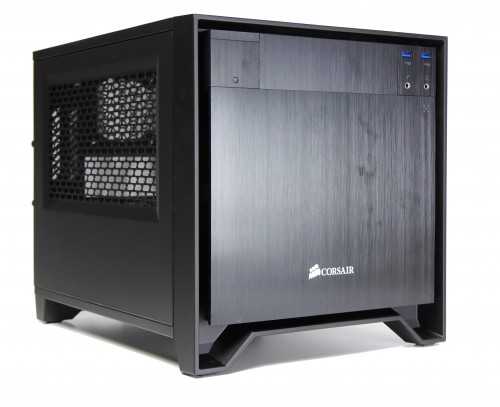
» Fotostrecke
Corsair вложила в комплект поставки Obsidian Series 250D только самые необходимые аксессуары. Вы получите инструкцию пользователя, несколько черных кабельных затяжек и три пакетика с винтами — на этом всё.
Перед тем, как мы приступим к тестам, позвольте привести базовые спецификации корпуса в табличном виде:
| Спецификации: Corsair Obsidian Series 250D (CC-9011047-WW) | |
| Производитель и модель: | Corsair Obsidian Series 250D |
| Материал: | Сталь, пластик, алюминий |
| Габариты: | 277 x 290 x 351 мм (Ш x В x Г) |
| Форм-фактор: | Mini-ITX |
| Отсеки накопителей: | 1x 5,25″, 2x 2,5/3,5″, 2x 2,5″ |
| Вентиляторы: | 2x 80 мм (сзади, опционально), 1x 120/140/200 мм (спереди, 1x 140 мм предустановлен), 2x 120 мм (сбоку, 1x 120 мм предустановлен) |
| Вес: | Около 6 кг |
| Цена: | 89 евро |
<>Тест и обзор: Corsair Obsidian Series 250D — стильный корпус mini-ITXCorsair Obsidian 250D | Внешний вид (1)
The Build and Finished Product
When I got to the point of needing to remove a bay cover for the ODD, I looked to see how it all goes about. I found four tabs inside the chassis that after releasing the lower section, will allow the top of the bezel to come out. This allows you to remove the bay covers, and you can see that the wires stay with the chassis.
To remove a bay cover, Corsair uses a tab on both sides to lock them into place. All you have to do is press the tabs inward and the cover will slide out the front of this section of the bezel.
Once the cover is removed, the entire width of the section is inset as it exposed textured plastic to flank the DVD drive. Personally, I would do away with an ODD in this chassis because this really disturbs the sleekness that it had out of the box.
What seemed really roomy at first was found to be quite tight. I had to angle the motherboard to avoid the ODD rack to get it installed, and when the build is complete, there isn’t a whole lot of room to add much more.
There weren’t too many issues out back. The dust shield snapped right in, the card lined up well, but for the PSU, I was short one screw, so I used it in the motherboard instead of filling all four holes of the PSU.
I was able to stuff every wire behind the motherboard tray. I took advantage of the well placed tie points, and all of the grommets were close enough to not leave a lot of the wiring on the inside of the chassis. There was slight resistance when I put the panel on, but due to the way they «hinge» at the front, it closed with little effort.
Just stepping back to soak it all in as I grab for the power cord so we can see what the 350D is all about.
When powered, the only lighting that you will deal with is the faint white glow of this pair of LEDs. The power LED, the one on the left, is actually illuminated currently. As for the light on the right, there is just an occasional flicker from it after the boot sequence has finished.
Just to give you an idea of what you can see through the window, I took this above image. As you can see, there is a great view of the components even without any help from LED lighting, but you also get a good view of the bays at the front, and that is something I would rather not see, personally.
Corsair Obsidian 350D Micro ATX Chassis
As you can tell, the front of the 350D definitely looks like it belongs in the Obsidian series, with the full aluminium panel and venting around its edges. The top holds the I/O panel above the pair of 5.25″ drive covers, while the lower section is removable to access a dust filter, without the need to remove the entire bezel from the chassis.
By pressing in at the top corners, the lower section opens downward until you can release a pair of tabs that keep the bottom of the plate in the bezel. Behind it you will find that dust filter. To remove or add fans here, you remove the filter and screw in the fans from there.
The front I/O panel offers a headphone and microphone jack next to the small reset button to the left. In the middle is the power button with the power LED and HDD activity lights on either side. Then the right side offers you a pair of USB 3.0 ports for easily accessed connectivity.
The top of the chassis offers these longer slits as a mesh panel to allow users to install optional fans. There are rubber grommets in the pair of 120mm mounting positions. If you want to use 140mm fans, you can, but you need to move the grommets.
The left side of the chassis shows that the front feet are part of the bezel, and the small feet at the back are designed to match. As for the side panel, the window used here stretches to within about an inch of the sides and offers a full view of the inside.
At the back the chassis starts with three break-away holes for optional water cooling, and is followed by the rear I/O and exhaust of the chassis. Taking it lower, you run into the five ventilated expansion slot covers, and the bottom hole is of course for the PSU.
The right side of the chassis is a dead match to the left, sans the window. There isn’t a bump out here to retain extra wiring, but to help, these panels open like car doors as the pivot on the front of the chassis once the thumbscrews are removed.
Under the chassis you will find a dust filter for under the PSU that slides out the back for cleaning. You will also see, if you look closely, that there are screws to allow for the removal of the HDD rack that is on the floor.
Specifications, Availability and Pricing
The Obsidian 350D is actually specified as a mid-tower chassis, but this one will only take on a Micro-ATX or Mini-ITX motherboard. The chassis only stands 17.7″ tall, is 17.3″ deep, and is 8.3″ in width. This chassis is mostly steel in construction, and as for the outside of the chassis, only the bezel, feet, and the large window are made of plastic. The front of the chassis is very flat and offers black brushed aluminum running from top to bottom, even over the pair of 5.25″ bay covers. The left side of the chassis offers a flat panel, and centered with just more than an inch on all sides is the window to view inside the chassis. In the back you have only five expansion slots, three potential holes for water cooling, and room at the bottom for a PSU. The left side of the chassis is just a flat expanse of steel with textured paint like the rest of the chassis has.
Internally there is a nice layout for all of the components. At the top of the front you have the tool-free bays for the 5.25″ drives, and hanging below is a removable plastic rack for 2.5″ drive. After a large gap that allows the 120mm fan to be installed in the front to blow into the chassis, there is also a rack for a pair of 3.5″ drives on the floor. The motherboard tray is dropped down since the largest motherboard that can fit is a Micro-ATX, this way AI/Os and custom loop radiators can be installed at the top with no interference. The tray itself offers a huge access hole for the CPU cooler back plate, as well as offering six large wire management holes, and ten places to attach wiring behind it. In the rear of the chassis you have the second and final 120mm fan installed there, and the five expansion slot covers are held in with thumbscrews, inside of the chassis.
As I look around at the time of writing, it seems that the 350D is not quite ready for sale at this moment. What I am seeing is pre-orders in any e-tailer I am seeing this chassis. Amazon is listing the chassis for $104.99, offers free shipping, but shows shipping will take one to three months. I also see a listing on Newegg, the same one that went live way too early, is now showing as discontinued with no mention of pricing now. The third option to obtain this chassis is to order direct from Corsair at $109.99 for the chassis, but are also listing zero quantity as I write this.
So, if the Corsair Obsidian 350D seems like the right chassis for your next build, you may have to wait just a little bit to obtain yours.
Seite 1: Test: Corsair Obsidian Series 350D — Micro-ATX-Gehäuse für High-End-Hardware
Micro-ATX-Gehäuse und Wasserkühlung — beides ist meist schwer miteinander vereinbar. Doch mit dem Obsidian Series 350D hat Corsair einen Mini-Tower auf den Markt gebracht, der das Wasserkühlen eines Micro-ATX-Systems leicht machen soll. Als Modell der Oberklassenserie bietet das Gehäuse aber auch abseits des Kühlsystems eine vielversprechende Ausstattung. Wir haben uns das kleine Obsidian Series 350D genauer angesehen und überprüft, ob es wirklich für High-End-Hardware im Micro-ATX-Format geeignet ist.
Wer ein neues Gehäuse kaufen möchte, stößt auf eine riesige Auswahl an Modellen von zahlreichen Herstellern. Aus der großen Masse können nur wenige Modelle herausstechen — entsprechend fieberhaft suchen die einzelnen Hersteller nach Möglichkeiten, ihre Gehäuse möglichst einzigartig zu machen. So hat Corsair offenbar darauf reagiert, dass vergleichsweise wenige Gehäuse werkseitig für den Einbau einer leistungsstarken Wasserkühlung geeignet sind. Mit den zwei jüngsten Modellen der Obsidian Series versucht das Unternehmen ganz gezielt, die Nutzer anzusprechen, die ihr System mit Wasser kühlen wollen.
Trotz gleichem Einsatzschwerpunkt und identischer Designsprache könnten die beiden Gehäuse unterschiedlicher kaum sein. Das Obsidian Series 900D (zu unserem Test) ist ein riesiges HPTX-Gehäuse für die außergewöhnlichsten Projekte. Dagegen wirkt das Obsidian Series 350D als ein geradezu vernünftiges Gehäuse. Dass Corsair im kleinsten (und günstigsten) Obsidian Series-Modell maximal den Einbau von Micro-ATX-Mainboards ermöglicht, ist dabei ein durchaus nachvollziehbarer Schachzug. Es gibt zum einen durchaus Enthusiastenmainboards mit diesem Format (zum Beispiel die Gene-Modelle von ASUS), zum anderen hat mittlerweile kaum ein Hersteller daran gedacht, Micro-ATX-Gehäuse für Wasserkühlungen zu optimieren. Das Obsidian Series 350D besitzt also ein Alleinstellungsmerkmal (Neudeutsch unique selling proposition, USP): Es ermöglicht als Micro-ATX-Gehäuse die einfache Montage von zwei 240er-Radiatoren. Gleichzeitig wurde der Neuling so gestaltet, dass er den Einbau von High-End-Hardware zulässt. Zwei lange High-End-Grafikkarten lassen sich genauso montieren wie viele Towerkühler.
Diese Flexibilität hat aber ihren Preis: Wirklich kompakt ist das Obsidian Series 350D mit Maßen von 210 x 440 x 450 mm nicht. Das Raumwunder SilverStone Sugo SG09 (zu unserem Test) kommt als konkurrierendes Micro-ATX-Gehäuse dagegen mit 220 x 295 x 354 mm aus. Das Corsairgehäuse ist in der Micro-ATX-Welt also etwa das, was unter den Mini-ITX-Gehäusen das BitFenix Prodigy (zu unserem Test) ist: Ein Gehäuse, das kaum Grenzen setzt, aber dafür auch vergleichsweise viel Platz braucht. Beim Preis liegt das jüngste Obsidian Series-Modell ebenfalls etwas über den meisten Konkurrenzprodukten: Für 109 Euro kann man auch manchen guten Midi-Tower kaufen. Angesichts der bemerkenswerten Wasserkühlungsoptionen und der Abkunft aus Corsairs High-End-Serie wirkt dieser Preis aber durchaus gerechtfertigt.
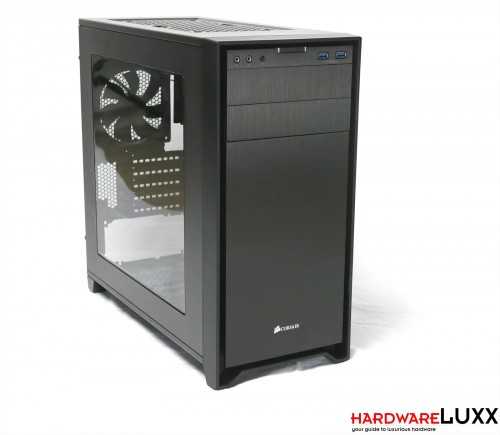
» Fotostrecke
Für einen ersten Eindruck haben wir das Corsair Obsidian Series 350D in einem ausgepackt & angefasst-Video gezeigt:
Alternativ bieten wir auch eine YouTube-Version des Videos an.
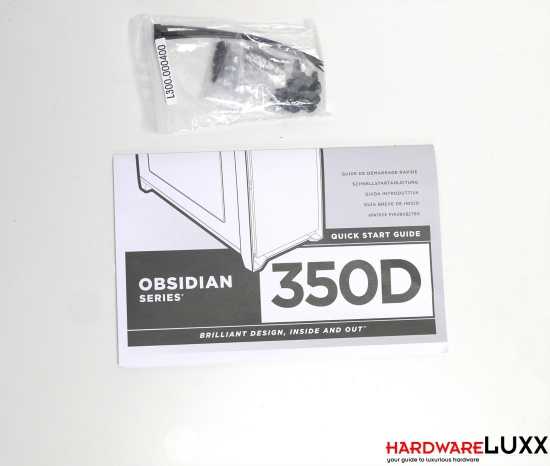
Der Lieferumfang ist sehr überschaubar. Nur das Montagematerial (bei dem wir die Netzteilschrauben vermisst haben), eine Bedienungsanleitung und einige Kabelbinder werden mitgeliefert.
Bevor wir mit dem eigentlichen Test beginnen, hier die Eckdaten des Gehäuses in tabellarischer Form:
| Eckdaten: Corsair Obsidian Series 350D | |
| Bezeichnung: | Corsair Obsidian Series 350D |
| Material: | Stahl, Kunststoff, Aluminium |
| Maße: | 210 x 440 x 450 mm |
| Formfaktor: | Micro-ATX, Mini-ITX |
| Laufwerke: | 2x 5,25 Zoll (extern), 2x 3,5 Zoll (intern, optional auch für 2,5 Zoll), 3x 2,5 Zoll (intern) |
| Lüfter: | 1x 120 mm (Rückseite, vorinstalliert), 2x 140/120 mm (Front, 1x 140 mm vorinstalliert), 2x 140/120 mm (Deckel, optional) |
| Gewicht: | ca. 6 kg |
| Preis: | 109 Euro |
<>Test: Corsair Obsidian Series 350D — Micro-ATX-Gehäuse für High-End-Hardware Äußeres Erscheinungsbild (1)
Внешний вид
Дизайн корпуса Corsair Obsidian Series 250D отдаленно напоминает кое-какие модели созданные инженерами Corsair еще в 2013 году. Однако, это нисколько не приуменьшает его притягательность. Передняя панель выполнена из алюминиевых пластин черного цвета, окруженных пластиковой каймой того же цвета. Эта рама спускается вниз, где она четко формируется в передние ножки корпуса.
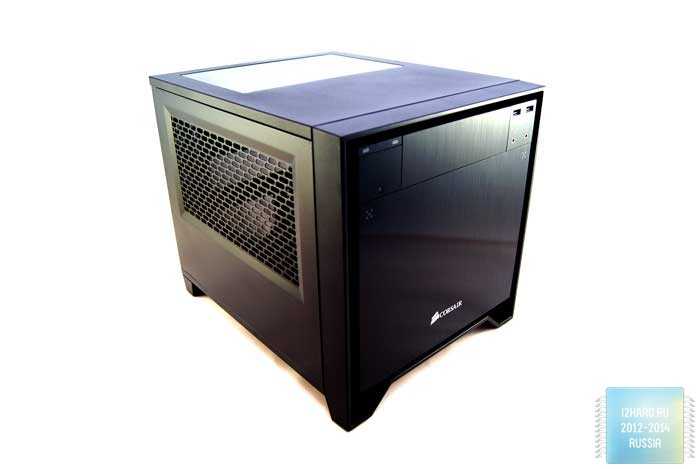
Кнопки включения и управления легко заметны на передней панели в верхней ее части. Небольшая круглая кнопка слева выполняет функцию сброса (Reset). Однако использовать ее можно, только если вы вооружитесь острым тонким предметом, случайно вы её не нажмете. В верхней части панели можно, так же, заметить два скоростных порта USB 3.0 и два разъема mini-jack для подключения наушников и микрофона. Между кнопками включения и разъемами портов USB 3.0 размещена заглушка отсека оптического накопителя 5,25″.
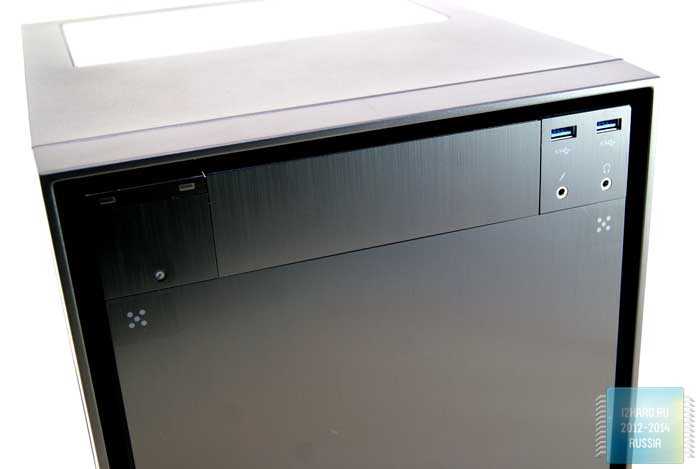
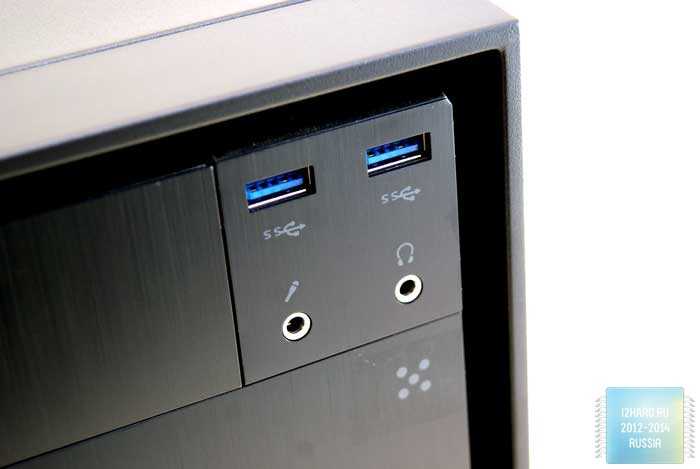
Надавив на два верхних угла алюминиевой лицевой панели, вы получаете возможность открыть ее и получить доступ к переднему пылевому фильтру, который можно легко снять для очистки или промывки под струей воды. За фильтром располагается предустановленный 140-мм вентилятор, вместо которого можно опционально установить вентиляторы других размеров, таких как 120-мм или 200-мм.
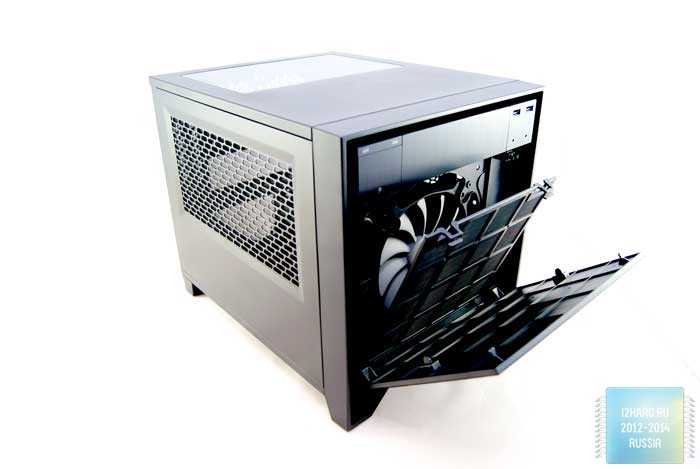
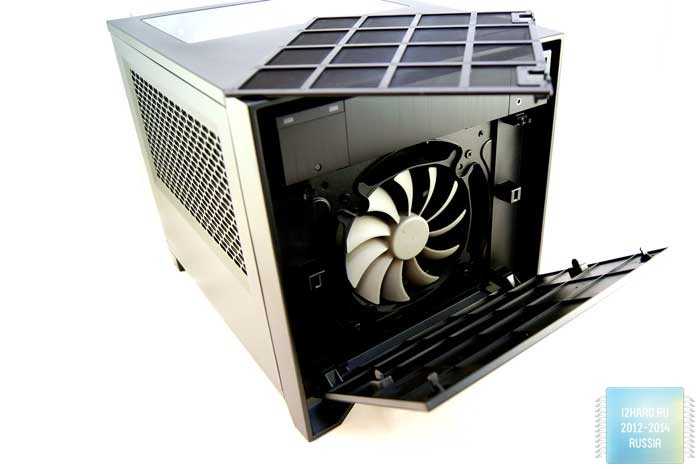
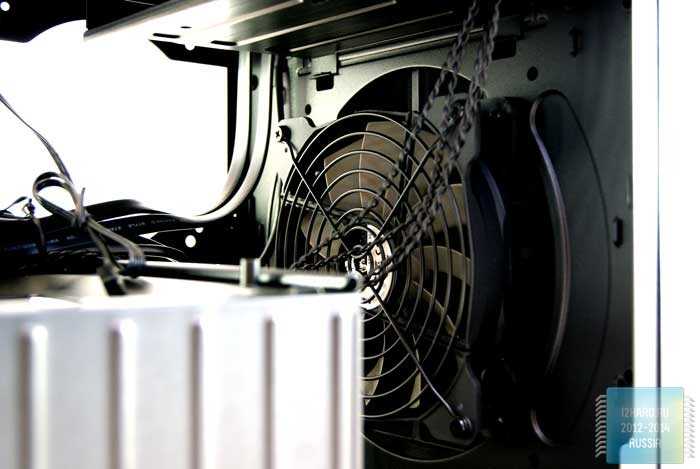
Обе стороны корпуса закрываются боковыми панелями с многочисленными вентиляционными отверстиями. Снимаются они очень просто, достаточно открутить винты с накатанной головкой. Стенки имеют противопылевые фильтры, которые крепятся на магнитных фиксаторах. Они легко «прилипают» к металлической поверхности закрывают отверстия боковых панелей от лишней пыли. Они так же могут быть легко сняты для очистки воздухом или под струей воды.
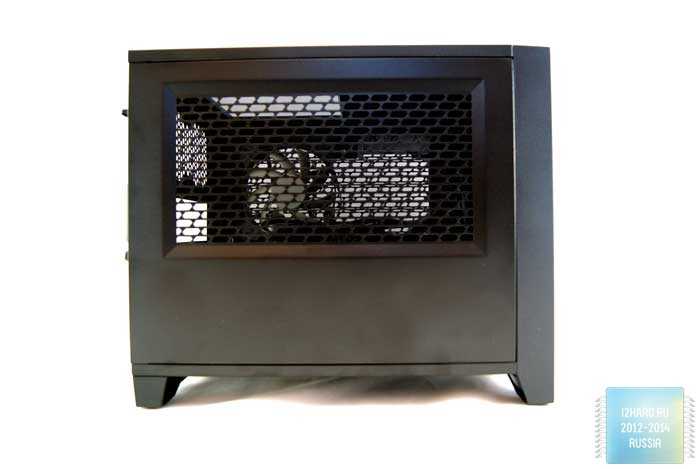
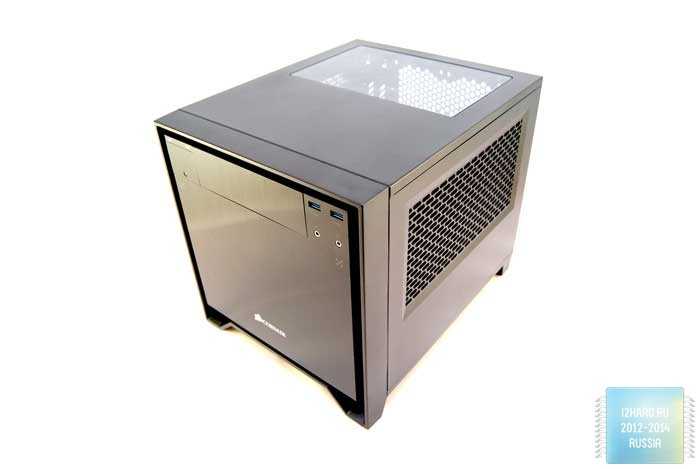
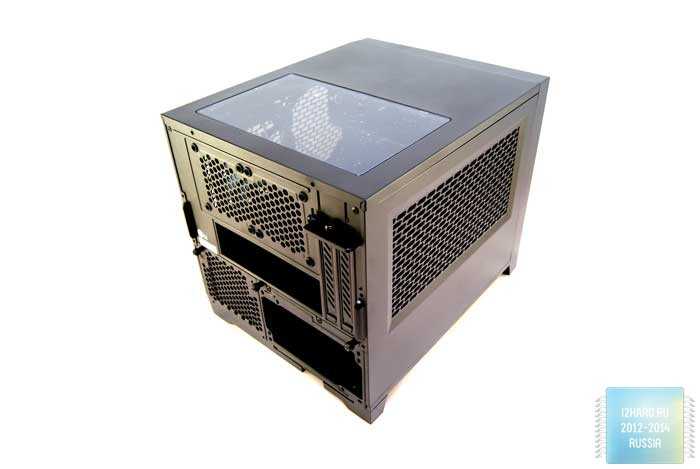
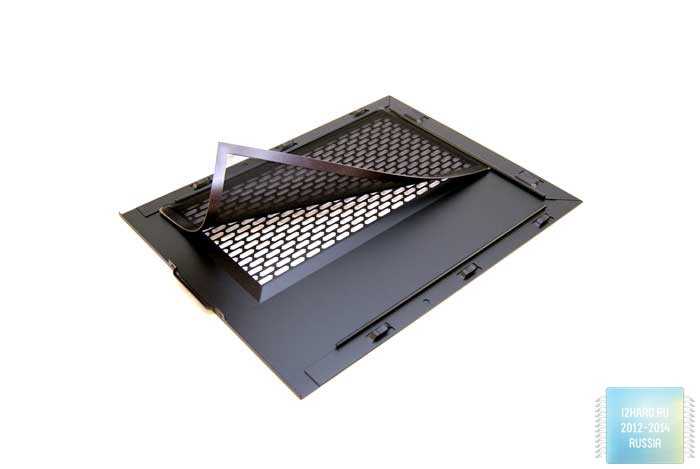
Нижняя часть корпуса в большей степени имеет сплошную металлическую поверхность, однако имеется противопылевой фильтр под блоком питания, который может легко быть извлечен и очищен от пыли. Пластиковые ножки корпуса имеют резиновые накладки для изоляции и против скольжения.
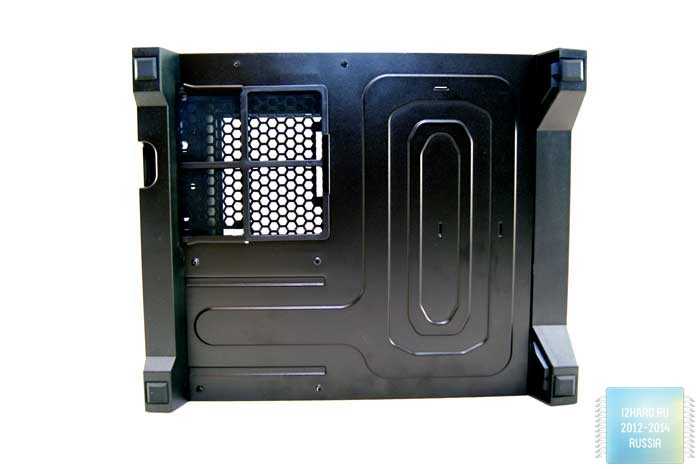
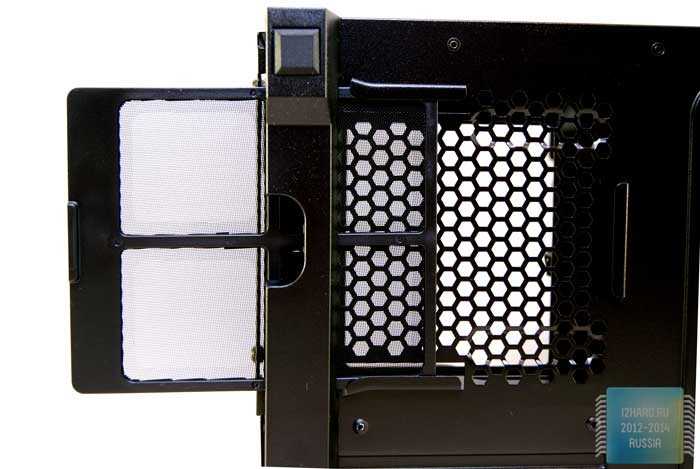
Задняя часть корпуса Corsair Obsidian Series 250D четко отражает расположение внутренних компонентов. Блок питания располагается снизу, а материнская плата размещается горизонтально над ним. Внутрь корпуса можно установить только двухслотовую видеокарту длинной не более 290 мм, этот фактподтверждают два слота расширения, которые видны на задней части корпуса. В верхней части задней панели имеются крепления для установки двух опциональных 80-мм вентиляторов. Отверстия для крепления имеют резиновые накладки, которые снизят шум и вибрацию.
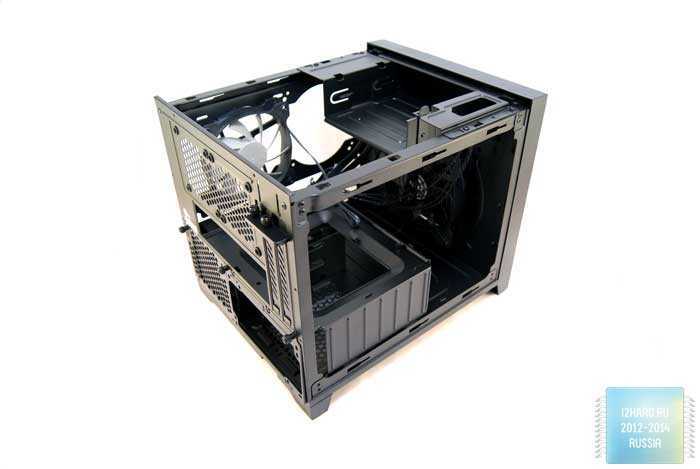
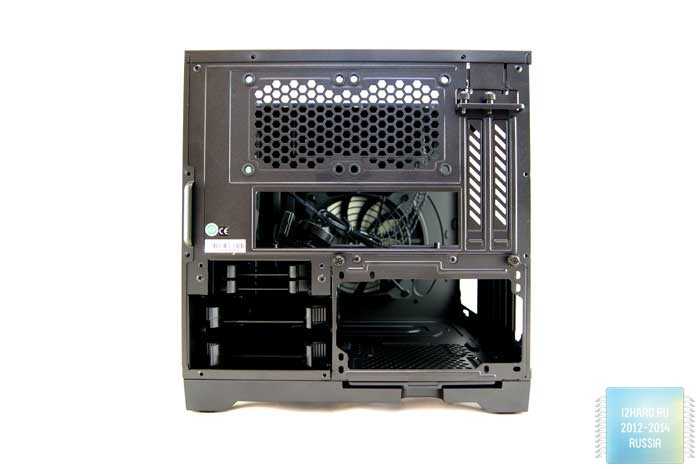
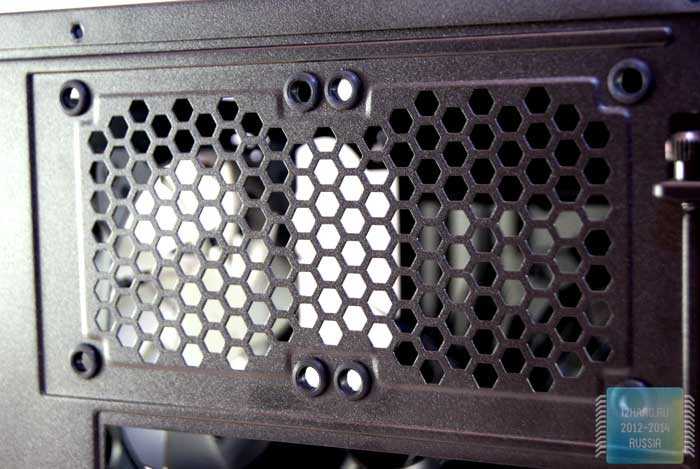
Верхняя часть корпуса обладает прозрачным окном, которое позволяет заглянуть внутрь корпуса.
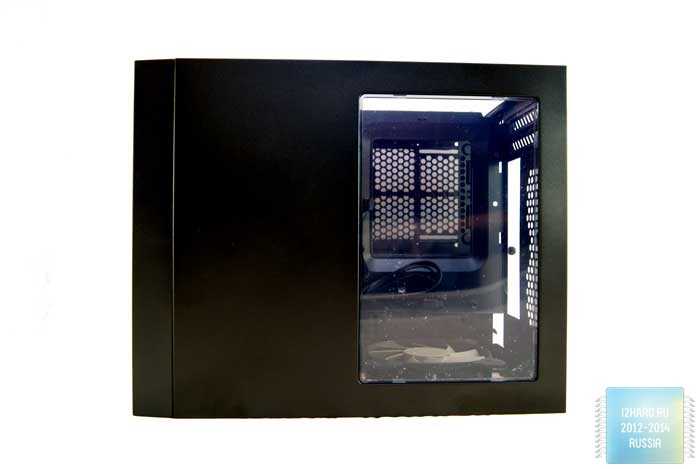
Инженеры компании Corsair настоятельно рекомендуют при монтаже удалить все боковые и верхнюю панели для удобства сборки иво избежаниеслучайного повреждения компонентов. Внешний осмотр закончен, и сейчас мы постараемся более детально рассмотреть интерьер корпуса.
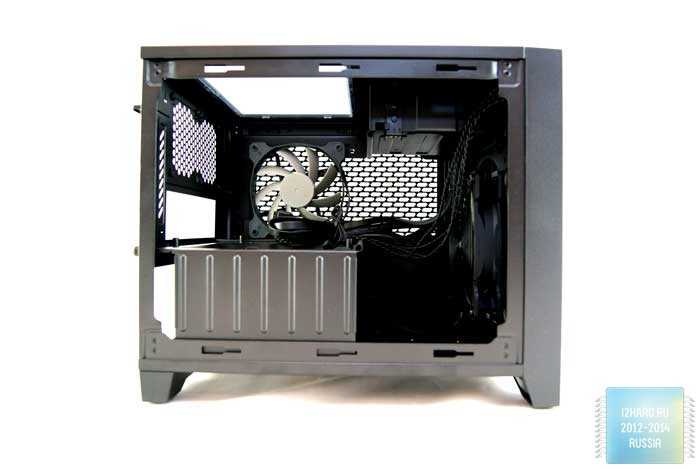
Внутреннее пространство
Как вы уже заметили, мы имеем горизонтальное расположение материнской платы внутри корпуса над блоком питания. При штатной высоте корпуса, в нашем случае, мы можем использовать в качестве системы охлаждения кулер высотой до 95 мм.Но этот размер может быть увеличен до 140 мм, за счет отказа от оптического привода и удаления держателя отсека оптического привода. Чем мы и пожертвовали в итоге.
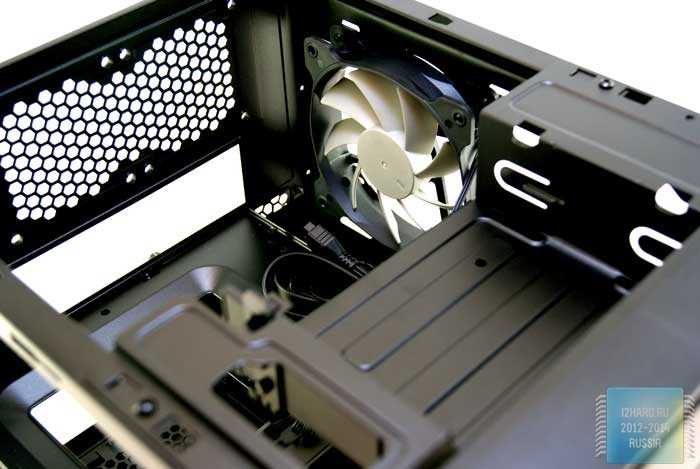
В последнее время стало хорошим тоном устанавливать системы водяного охлаждения замкнутого типа. Это не сильно удорожает вашу вычислительную систему, зато вы получаете эффективную и малошумную систему охлаждения. В корпусе Corsair Obsidian Series 250D предусмотрена такая возможность. За правой боковой стенкой можно заметить крепление для установки 240-мм теплообменника, в котором уже располагается штатный 120-мм вентилятор. При необходимости, его можно заменить на удобный для владельца.

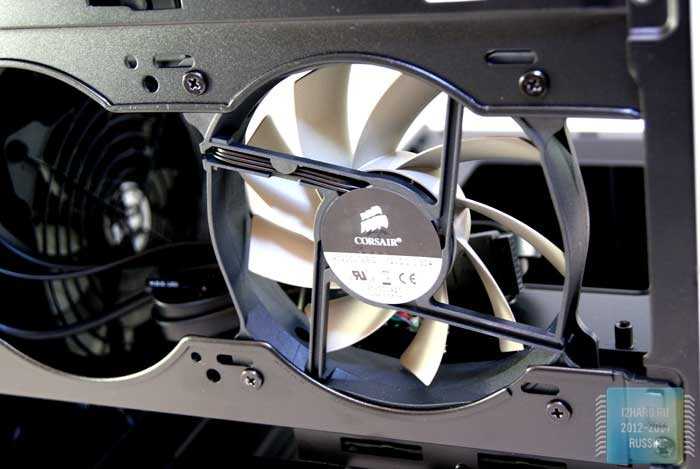
Необычным решением от инженеров компании Corsair стало расположение жестких дисков или твердотельных накопителей внутри корпуса. Вы не найдете здесь специальной стойки, как мы это уже привыкли наблюдать в классических корпусах. Корзина с HDD/SSD располагается с левой стороны от блока питания, в нижней части корпуса и доступ к ней ограничен с задней панели корпуса. Жесткие накопители фиксируются в специальных пластиковых лотках без помощи винтов и отвертки. Сами они задвигаются и фиксируются до щелчка так же без дополнительных усилий или инструментов. Два верхних лотка позволяют разместить два жёстких диска или SSD формата 2,5″, в двух нижних можно установить винчестеры формата 3,5″.
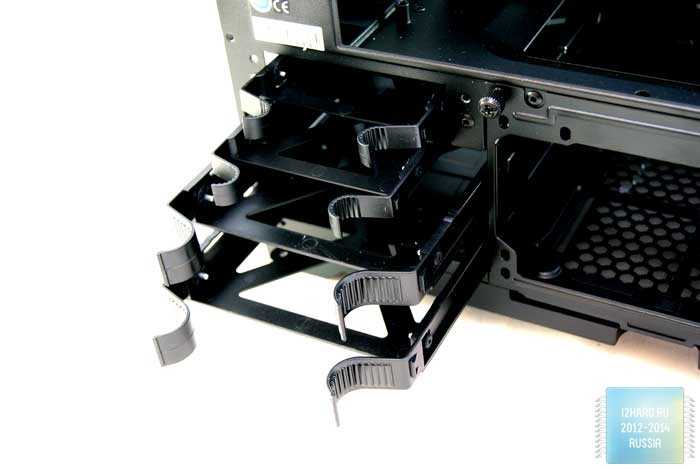
К сожалению, корпус не имеет специальных средств для прокладки и фиксации соединительных кабелей и кабелей питания. Это просто не предусмотрено конструкцией. Видимо поэтому в комплекте с корпусом идут 4 стяжки для удобства монтажа.
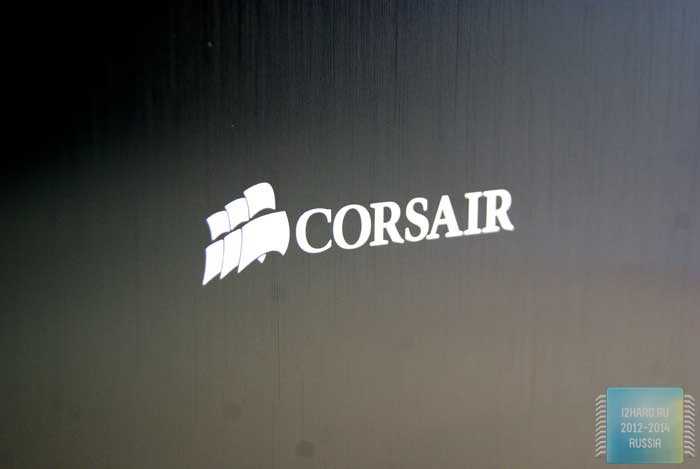
Final Thoughts
The Corsair Obsidian 350D is really hit and miss with me and I ponder what to say and how to address this case. While the external visual appeal is definitely Obsidian through and through, I feel that it is lost in the interior. Obsidian to me is just as unique and designed to allow something that not many other cases of their time could do. Here there is some uniqueness in certain things, but not enough to carry this prestigious name, in my opinion. Obsidian used to mean top of the line, the «end all, be all» of the Corsair lineup, and I feel here we got a lesser chassis in a sleek and sexy set of clothes. Don’t get me all wrong here, for the specific market for those who want compact, but don’t want to go into SFF chassis designs, this is a solid option to look at.
While I liked the sleek aluminum front insert, once you install a drive or a reservoir, you really break the aesthetic of the chassis. I also would have thought, that even at this price, we could have gotten more fans. Speaking of the fans, for such a compact area, they do allow the components to get a great amount of air flow, specifically since the front fan is uninterrupted by worthless bay drives. I do like the repositionable 2.5″ drive rack, and I like that the bottom HDD rack comes out. This way if you don’t want to use the top of the chassis for water cooling, you can address the front of the chassis for that too. I really liked the layout and room offered behind the motherboard tray, even if I did have to constantly fight the grommets from popping out.
There are some things that you need to consider up front as well. If you plan to use a dual radiator in the top of the chassis, you pretty much lose access to the top optical drive bay. If that isn’t a big deal, let us move to the front. While you can remove the HDD rack, you are limited in space to what you can get in some custom radiators or most sealed AI/O units. Something like a Swiftech H220 is not going to work well in the front of this chassis. I also advise that you plan the wiring out carefully behind the motherboard tray. While I was able to get all of the wiring in there, there was some resistance with the panel — any more of a rats nest than what I came up with is definitely going to make for an ugly bulge in the right side of the chassis.
One thing I did not really expect when looking at an Obsidian chassis was to ponder one being offered at $109.99. I will admit I didn’t follow this chassis that closely when the news hit of its release, but unless you have a specific need, or are looking to match the memory, PSU, AI/O cooler, and the chassis for a Micro-ATX or Mini-ITX build that needs room for longer video cards, I just think there are better offerings out there. I know there are few that fit in this exact footprint that the 350D brings to the table, but I also think that other offerings like the Fractal Design ARC Midi R2, while slightly bigger overall, was the right choice in my humble opinion for my Micro-ATX system build.
I personally would have rather seen a $125 to $150 version of this case with some better engineering of the face plate once it was removed, maybe add a couple more fans, or at least swap them to the more attractive Air series fans. And maybe even cut the window down some so I don’t have to stare at my drive bays. The chassis is genuinely a nice product with quite a few usable options, I just expected more with an Obsidian series chassis.






























